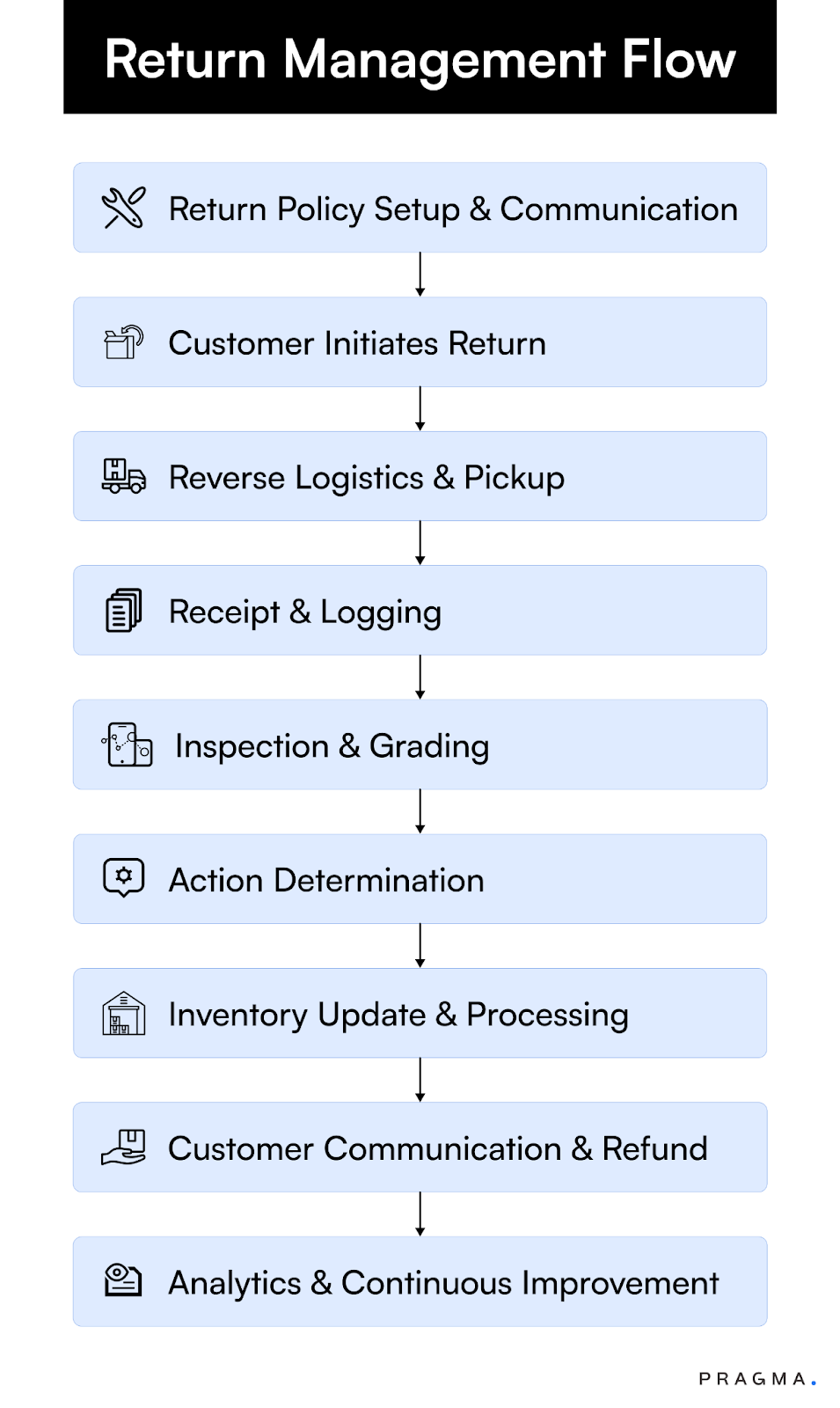
When a customer places an order with your business, you feel overwhelmed and begin the shipping process. After a few days, you will see that the customer has submitted a return request. This feels disgusting, as you thought that these returns would eat all your profits.
But this is not necessarily true. Returns are an integral part of the e-commerce experience, and no business can completely prevent them. The difference between the winning brands is that they treat returns as opportunities to improve rather than as a problem.
This blog will explore the practices covering "How to Handle Customer Returns." Because handling returns well is a part of the business that will decide whether the customer will stay loyal to the brand or just leave it because of the bad return management.
Why Handling Customer Returns Well Matters?
When a customer wants a product from a brand, the first thing that he sees is the return policy if he wishes to buy it. That is why every D2C brand should have a well-established return process, and handling returns well is essential because:
Happy Customers Come Back
If you make returning something easy, the customer will have built trust in the brand because of the easy returns. And even if that product does not suit him, he will still plan to buy another product from the brand. Here are some fascinating numbers that prove this:
- 92% of people will shop again with a store if returning items is easy
- 72% of customers will buy more from stores that make returns simple
- But 84% of customers will never shop again after a bad return experience
Indian Shoppers and Returns
In India, online shopping is growing fast. Here's what we know:
- About 3 out of every 10 things bought online get returned
- 67% of Indian shoppers check the return policy before buying anything
- Nearly half of all shoppers want "simple, free returns" to feel confident about buying online
Chance to Sell High-Value Products More
When your brand has a proper return policy, the customer will never hesitate to buy a more expensive product, because they know if anything goes wrong, your brand will handle it well. So, this increases the chance that you can sell more expensive products easily.
What are the Most Common Reasons Behind Returns?

- Size and Fit Issues
- Product Quality Issues
- Damaged Products
- Products not working
- Wrong Product Shipped
- Change of Mind of Customer
- Customer Unavailability
These are the most common reasons for which customers returned products. Let us now move to how to handle customer returns.
Step-by-Step Guide on How to Handle Customer Returns
1. Create Clear and Transparent Return Policies
The return policy is one of the essential sales tools, but many D2C brands do not know about it. A return policy should be that much easier and understandable so that a customer, when visiting, clearly understands it.
What Your Policy Should Include:
- It should be written in easy words. There must not be any technical jargon that a normal person can't understand.
- The return policy should have a clear timeframe in writing. The exact number of days should be mentioned.
- Tell customers exactly what can and can't be returned.
- The return policy should be easy to find. It should not be like that; the customer has to search for it. Put it on product pages, checkout, and your website footer.
2. Design a Streamlined Returns Process
A return process must be easy for the customers. Here is how it should be:

Step 1 - Return Request: Make it easy for customers to start returns from their account. Ask what they want: refund, exchange, or store credit.
Step 2 - Item Receipt: When the returned item arrives at your warehouse, immediately notify the customer and start processing the return.
Step 3 - Quality Check: Inspect the item quickly. Decide whether you can resell it? Does it need refurbishing?
Step 4 - Resolution: Process refunds or send replacements within 24-48 hours of receiving the item. This is one of the essential steps, because customers want faster refunds.
Step 5 - Data Collection: Although you have processed the return, it is essential to know why it has been returned. Look for the following things:
- What's the reason behind the return?
- What issue does the customer face?
This will help you improve your products and reduce future returns.
3. Train Your Customer Service Team
Your customer service team is like the face of your company during returns. They should be extremely helpful to the customers.
What your team should do:
- Be fast: Don't make customers wait days for help
- Make it easy: Don't create complicated steps
- Keep customers updated: Tell them what's happening with their return
- Give choices: Let them pick between money back, exchange, or store credit
Keep in mind that 67% of people won't shop with you again if they have a bad return experience.
4. Analyse and Improve Your Returns Data
Always collect the data, analyse it, and take action on how to improve because returns are like the teacher that can teach you how you can improve.
Key Metrics for Your Business:
- Return rate by product: Which items are costing you the most in returns?
- Return reasons: Are customers returning due to quality, sizing, or wrong expectations?
- Processing time: How fast are you handling returns compared to competitors?
- Customer satisfaction scores: Are customers happy with your returns process?
- Cost per return: What's the actual cost of each return to your business?
How can you use this data to improve? Have a look!
If you are getting higher return rates on a particular product, then see what the reason is behind it. If there are no clear product descriptions, then add them properly. Add proper images from multiple angles, so that a customer clearly knows what he is buying.
If you are getting lots of size-related returns, then improve your size charts. It should be true to your product.
If the reason is slow processing times, switch to better automation tools.
By doing these practices, you will be aware of how to handle customer returns well in an efficient manner.
How to Handle Customer Returns? – Real Examples from Indian E-commerce
Let's look at how real Indian companies solved their return challenges and what you can learn from them:
Case Study 1: How Emami Saved Millions with Smart Returns

Emami, a popular D2C brand, is facing many rejections on their COD orders. 85% of their customers chose COD, but many refused delivery, costing Emami double shipping fees.
This became their major challenge! But how did they manage this?
They partnered with Pragma to use their Return Management System that analyses 300+ data points in 0.2 seconds to identify risky orders before shipping
And the results they get are fascinating:
- Increased prepaid orders from 25% to 35%
- Reduced refused deliveries by 60%
- Cut delivery problems by 35%
- Reduced information-related returns by 45-60%
From this, what you can learn is that investing in proper technology will not cost you, but it will help you save more. Choose tools like Pragma that tell us certain pin codes, payment methods, or customer behaviours linked to higher return rates?
Case Study 2: How ‘bummer’ Automated Their Way to Success?

Bummer, facing a major issue in handling returns manually, was taking too much time. Their staff was spending hours every day just processing returns, and customers were getting frustrated with delays.
What they did!
They used automated software that could handle returns, exchanges, and refunds automatically without human help.
And the results are amazing!
- Returns got processed 87.5% faster
- 74% fewer return requests (because the process was so smooth)
- Staff could focus on other important work
- Customers are happier.
Case Study 3: The Free Returns Strategy
Some companies offer free returns; their customers don't pay anything to send items back.
Why It Works: When people know they can return things for free, they're more likely to buy in the first place. They think, "If I don't like it, I can just send it back."
The Results:
- More people buy things
- Customers trust the brand more
- People tell their friends about the good experience
If free returns increase your sales by 20% but only cost you 5% in additional expenses, you're ahead by 15%.
Tools & Automation for Returns Management
As a D2C brand, you wish to grow and make a profit. You must not want to waste your time handling returns and processing them manually. And what will prevent them? These can be the return management tools! Here are some of the best tools and automations that will work for you.
Returns Management Systems (RMS)
A return management system will be a good tool to start with. What It Does for Your Business:
- Automates return labels: Saves staff time and reduces errors.
- Tracks inventory in real-time: It helps to know exactly what's returned and when.
- Processes refunds automatically: It helps in doing faster refunds. And this means that there will be happy customers.
- Generates business insights: Understand return patterns to reduce them.
- Integrates with your existing systems: Works with your e-commerce platform and accounting software.
Data for better understanding:
If an RMS costs ₹50,000 per year but saves 10 hours of staff time per week, you're saving ₹2,40,000+ annually in labour costs alone.
Integrated Customer Support Solutions
What benefits does this provide?
- Customer service agents see the complete return history during calls
- Automatic ticket creation for return issues
- Unified customer profiles showing purchase and return patterns
- Proactive outreach to prevent returns
Pragma's RMS and Omnichannel CRM

Pragma offers an integrated RMS and Omnichannel CRM that:
- Connects all customer touchpoints
- Uses data from 1000+ brands to identify fraud patterns
- Provides complete customer journey visibility
- Helps prevent returns through predictive analytics
What to Look for When Choosing Returns Tools:
- Scalability: Will it help to grow your business?
- Integration capabilities: Does it work with your current e-commerce systems or not?
- Analytics and reporting: Can you get actionable business insights?
- Automation features: How much manual work does it eliminate?
- Customer experience: Does it make returns easier for your customers?
To Wrap It Up
Returns are a part of business. No business can skip them, but can prevent and handle them with the help of proper return management strategies and tools.
- Good returns management increases customer satisfaction by 18%.
- It can reduce your overall costs by 5%.
- 92% of customers will buy again after a positive return experience.
- Companies with great return policies often see 20%+ higher conversion rates.
And with Pragma, you can achieve better management through the Return Management Suite. It is here for all D2C Brands to handle returns, minimising costs and maximising their profits.

FAQs (Frequently Asked Questions On How to Handle Customer Returns?)
1. What is a good first step when a customer returns a product?
A clear and concise returns policy is critical. It should define what items are eligible, time windows, and conditions. Many brands display this prominently to build trust.
2. Should returns be allowed both online and in-store (if applicable)?
Yes. Offering omnichannel returns (online customers returning to physical stores) improves convenience. In some markets, ~47% of customers prefer in-store returns.
3. How important is speed in refunds or replacements?
Very important. Customers expect fast action—once their return is approved, the refund or replacement should follow promptly. Slow refunds damage loyalty.
4. What role does return data analysis play?
You should record and analyse return reasons. Recurring issues (size mismatch, damaged goods, misleading images) point to fixes you must make in product pages, packaging or QC.
5. How can brands reduce unnecessary returns using product detail strategy?
- Use detailed descriptions, multiple images, size charts, videos.
- Be precise about dimensions, colours, texture so customers know what to expect.
6. What are good tactics to encourage exchanges over returns?
Offer incentives for exchanges (discount, waived shipping) rather than full refunds. This often retains revenue and reduces logistics burden.
7. How should communication be handled during returns?
Keep the customer updated at every stage—when you receive the return, inspect it, approve it, process refund or send replacement. Transparency fosters trust.
8. Can automation help with returns?
Absolutely. Use a Returns Management System (RMS) or cloud solution to automate RMA issuance, notify customers, update inventory, and manage refund flows.
9. Are there real brand examples of handling returns well?
Yes. Many global brands showcase strong returns policies (e.g. Everlast with a 30-day returns window) that simplify the process for customers and reduce friction.
Another example: Brands that allow returns to stores make the process more convenient and reduce logistical burdens.
Talk to our experts for a customised solution that can maximise your sales funnel
Book a demo




.png)